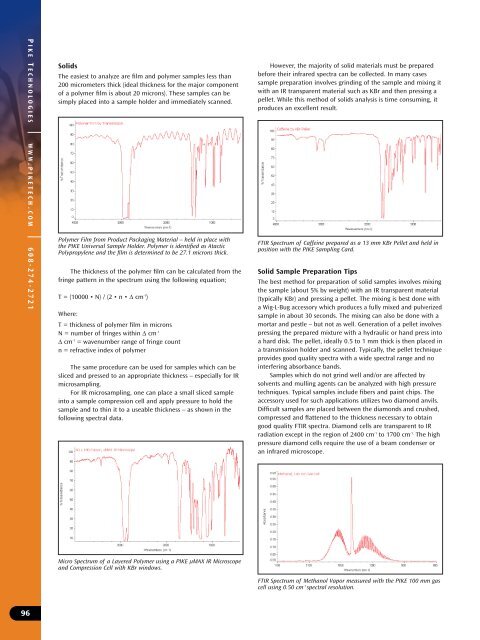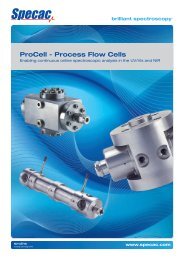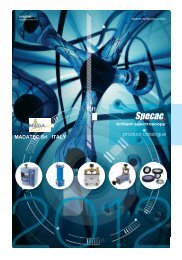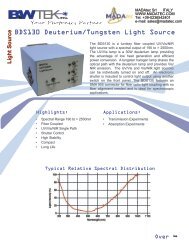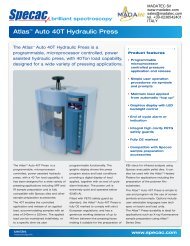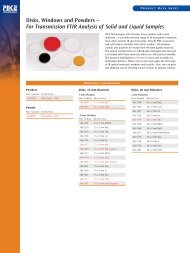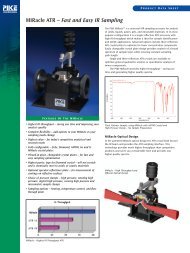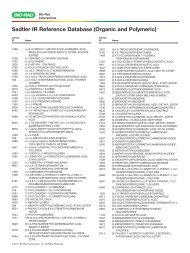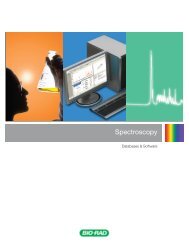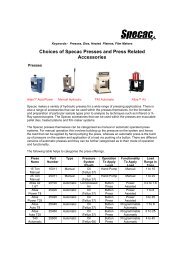Pike Technologies Comprehensive Catalog of FTIR ... - Madatec
Pike Technologies Comprehensive Catalog of FTIR ... - Madatec
Pike Technologies Comprehensive Catalog of FTIR ... - Madatec
Create successful ePaper yourself
Turn your PDF publications into a flip-book with our unique Google optimized e-Paper software.
P IKE T ECHNOLOGIES WWW. PIKETECH. COM 608-274-2721<br />
Solids<br />
The easiest to analyze are film and polymer samples less than<br />
200 micrometers thick (ideal thickness for the major component<br />
<strong>of</strong> a polymer film is about 20 microns). These samples can be<br />
simply placed into a sample holder and immediately scanned.<br />
Polymer Film from Product Packaging Material – held in place with<br />
the PIKE Universal Sample Holder. Polymer is identified as Atactic<br />
Polypropylene and the film is determined to be 27.1 microns thick.<br />
The thickness <strong>of</strong> the polymer film can be calculated from the<br />
fringe pattern in the spectrum using the following equation;<br />
T = (10000 • N) / (2 • n • Δ cm -1 )<br />
Where:<br />
T = thickness <strong>of</strong> polymer film in microns<br />
N = number <strong>of</strong> fringes within Δ cm -1<br />
Δ cm -1 = wavenumber range <strong>of</strong> fringe count<br />
n = refractive index <strong>of</strong> polymer<br />
The same procedure can be used for samples which can be<br />
sliced and pressed to an appropriate thickness – especially for IR<br />
microsampling.<br />
For IR microsampling, one can place a small sliced sample<br />
into a sample compression cell and apply pressure to hold the<br />
sample and to thin it to a useable thickness – as shown in the<br />
following spectral data.<br />
However, the majority <strong>of</strong> solid materials must be prepared<br />
before their infrared spectra can be collected. In many cases<br />
sample preparation involves grinding <strong>of</strong> the sample and mixing it<br />
with an IR transparent material such as KBr and then pressing a<br />
pellet. While this method <strong>of</strong> solids analysis is time consuming, it<br />
produces an excellent result.<br />
<strong>FTIR</strong> Spectrum <strong>of</strong> Caffeine prepared as a 13 mm KBr Pellet and held in<br />
position with the PIKE Sampling Card.<br />
Solid Sample Preparation Tips<br />
The best method for preparation <strong>of</strong> solid samples involves mixing<br />
the sample (about 5% by weight) with an IR transparent material<br />
(typically KBr) and pressing a pellet. The mixing is best done with<br />
a Wig-L-Bug accessory which produces a fully mixed and pulverized<br />
sample in about 30 seconds. The mixing can also be done with a<br />
mortar and pestle – but not as well. Generation <strong>of</strong> a pellet involves<br />
pressing the prepared mixture with a hydraulic or hand press into<br />
a hard disk. The pellet, ideally 0.5 to 1 mm thick is then placed in<br />
a transmission holder and scanned. Typically, the pellet technique<br />
provides good quality spectra with a wide spectral range and no<br />
interfering absorbance bands.<br />
Samples which do not grind well and/or are affected by<br />
solvents and mulling agents can be analyzed with high pressure<br />
techniques. Typical samples include fibers and paint chips. The<br />
accessory used for such applications utilizes two diamond anvils.<br />
Difficult samples are placed between the diamonds and crushed,<br />
compressed and flattened to the thickness necessary to obtain<br />
good quality <strong>FTIR</strong> spectra. Diamond cells are transparent to IR<br />
radiation except in the region <strong>of</strong> 2400 cm -1 to 1700 cm -1. The high<br />
pressure diamond cells require the use <strong>of</strong> a beam condenser or<br />
an infrared microscope.<br />
Micro Spectrum <strong>of</strong> a Layered Polymer using a PIKE µMAX IR Microscope<br />
and Compression Cell with KBr windows.<br />
<strong>FTIR</strong> Spectrum <strong>of</strong> Methanol Vapor measured with the PIKE 100 mm gas<br />
cell using 0.50 cm -1 spectral resolution.<br />
96


